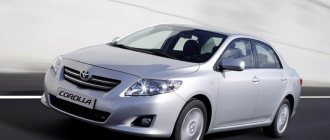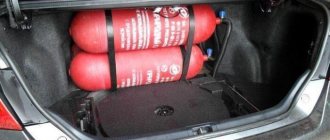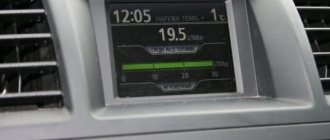Toyota Camry is the most popular class D car in our country. Almost a quarter of all cars are this particular model, although they have to compete with very serious options. Production of the Toyota Camry began back in 1983. The seventh generation has reached our time. The model was also repeatedly restyled.
Official data (l/100 km)
| Engine | Consumption (city) | Consumption (highway) | Flow (mixed) |
| 2.0 MT petrol (manual) | 7.1 | 6.9 | 7.0 |
| 2.0 AT petrol (automatic) | 10.0 | 5.6 | 7.2 |
| 2.4 MT petrol (manual) | 11.6 | 6.7 | 8.5 |
| 2.4 AT petrol (automatic) | 13.6 | 7.8 | 9.9 |
| 2.5 MT petrol (manual) | 10.6 | 7.1 | 9.0 |
| 2.5 AT petrol (automatic) | 11.0 | 5.9 | 7.8 |
| 3.5 AT petrol (automatic) | 13.2 | 7.0 | 9.3 |
Line of Toyota Camry engines 1-9 generations
The first three generations of the model were not officially supplied to other countries. The manufacturer equipped the Toyota Camry 1-3 with two engines of 1.8 and 2.0 liters. The car was sold under the V10 brand and was structurally a rear-wheel drive sedan. Over time, a station wagon modification also appeared. Over time, the manufacturer decided to abandon the 1.8-liter engine, but the two-liter naturally aspirated analogue was retained, and was subsequently subjected to design changes more than once.
The model is officially supplied to Russia with three different engines:
- naturally aspirated 6AR-FSE 2 liters with a stated power of 150 horsepower;
- petrol 2AR-FE 2.5 liters with a power of 181 horsepower;
- 3.5-liter engine labeled 2GR-FKS and 249 horsepower.
All three developments are new engines: 6AR-FSE and 2AR-FE replaced the AZ generation units. During the production of these motors, the manufacturer set itself one single goal - to achieve greater environmental friendliness. The engines are united by an aluminum cylinder block, but in AZ the liners are made of cast iron, which gives them reliability and resistance to critical temperatures. A distinctive feature of the 3.5-liter 2GR-FKS engine is the presence of a Dual-VVTi system, due to which the camshafts are driven by a single-row timing chain equipped with a valve timing system. The engine is sensitive and demanding of high quality fuel.
What affects fuel consumption
Camry gasoline consumption depends on engine size, fuel supply system, and gearbox type. The following factors have a significant influence:
- driving mode;
- air temperature;
- quality of road surface;
- use of heating and air conditioning;
- use of tires appropriate for the season;
- loading the car.
To eliminate excessive fuel consumption, service specialists recommend:
- ignition adjustment, idle air valve;
- cleaning injectors;
- regular replacement of oil, fuel and air filters;
- timely identification and elimination of technical faults.
An experienced driver can reduce fuel consumption using special skills. For effective savings, each of the listed points should be studied separately, taking into account the mutual influence of individual factors.
Fuel manufacturers, for example, add light fractions to simplify engine starting in winter. If you fill this type of gasoline in the summer, the rapid evaporation of the corresponding components will increase consumption. At the same time, the performance of the exhaust gas purification system will decrease, which will accelerate environmental pollution. Old oil has increased viscosity, which creates additional resistance to piston movement. The noted features explain the need to use high-quality fuels and lubricants that meet the intended purpose.
Tires are assessed in the same way. Soft “winter tires” improve grip on the road surface. However, at positive temperatures the influence of friction forces increases. Timely replacement of tires will prevent unnecessary operating costs during the summer season.
An aggressive driving style is accompanied by intense braking (acceleration). In this mode, basic fuel consumption increases, tires and brake pads wear out quickly. In urban conditions, such actions will reduce the time of a typical trip by an insignificant 5-10 minutes, but will significantly increase the risk of an emergency.
Driver reviews of Toyota Camry fuel consumption
Toyota Camry in the XV70 body is officially sold by dealerships in Russia from April 2021. The model is supplied to most of the European and Asian markets. For the most part, the car received praise from domestic car enthusiasts. The machine is equipped with durable and resource-intensive power units, it is inexpensive to maintain, convenient, practical and reliable. The latest generation of the model really looks bright and presentable on the roads, emphasizing the status of the owner. Cases of too high fuel consumption are extremely rare and are caused only by the technical condition of the vehicle.
Toyota Camry engines do not have any serious design flaws that, even in theory, could provoke “gluttony.” All this suggests that if data differing from the manufacturer’s standards regarding the level of fuel consumption is detected, first of all you should undergo car diagnostics in order to identify malfunctions of key systems - power supply, ignition, even incorrect tire pressure can correct its typos. What is the fuel consumption of a Toyota Camry per 100 km in practice will be described in detail by reviews from those who once owned or still own a Japanese sedan.
Engine 2.0
- Stanislav, Vorkuta. Hi all! I have a 2011 Toyota Camry 8th generation in the XV50 body. Over eight years of operation, it has covered over 190 thousand kilometers. I don’t use the car every day, but I have traveled around the country several times. Under the hood there is a 2-liter engine with a 4-speed automatic transmission, “Classic” equipment. This is a very reliable 1AZ-FE motor, belonging to the old generation of Japanese engines. Consumption always remained at the level of 8.5 and 7 liters city/highway, respectively. There were never any serious deviations from the norm. I regularly undergo scheduled maintenance and use original spare parts. In rare cases, in winter, the indicator increases by 0.5 due to forced downtime and subsequent warm-ups.
- Egor, Moscow. Many car owners are interested in the question of what kind of gasoline to pour into Toyota Camry 2.0? The car manual says that the fuel must have an octane rating greater than 91. I have always used AI-92, so far everything is fine. I usually fill up with 68 liters – a full tank – and ride until I’ve used up all the fuel. In city conditions, the consumption indicator shows 7.5 liters in ECO mode. On the highway this figure is 9 liters. The driving style is not too aggressive, but sometimes I like to press the pedal, as they say, especially when the track is empty.
- Andrey, Chita. I have a new sedan with a 2.0-liter engine with an automatic transmission in the “Classic” configuration. So far I have driven the car for 30,000 km, and I can say that after the break-in period the “appetite” of the car has decreased significantly. At first, the car consumed 8-8.5 liters per 100 km, but now the needle shows no more than 7.5 liters in Chita. Outside the city, it burns about 8 liters each, if you stick to a speed of 100-110 km/h, but if you press the accelerator pedal, the figure can increase to 9 or even 9.5 liters - personally verified.
- Albert, Tyumen. I own a 1998 Toyota Camry 2.0, 4th generation car. For the purity of the experiment, I tried to refuel at various gas stations. I found the most successful and suitable fuel supplier for myself. For example, I tried to fill up gasoline at Gazpromneft, and then at Lukoil. So, I can say that fuel consumption indicators with different gasolines can differ significantly. So, with the transition to AI-92 from Lukoil, I noticed that fuel began to be consumed almost twice as fast. I can’t say anything specific about these gas stations, but the fact remains that with gasoline from Gazproneft, the engine “eats” according to the manufacturer’s standards.
- Alexander, Moscow. I have a 1996 Toyota Camry with a 2-liter engine and a manual transmission. I believe that a high consumption rate is a price to pay for the age of the car. My car is already 23 years old and the mileage is 340,000 kilometers. Initially, the consumption was 8-8.5 liters, which corresponds to the standard certified by the manufacturer. But, after the mileage on the odometer exceeded 300,000 km, the needle began to show 10 l/100 km in Moscow. On an empty highway at 100 km/h it consumes 8 liters. What to do in such a situation? Buy a new car or install an LPG. But the last option is not a panacea. You will have to spend money on constant replacement of filters, lambda probe, etc.
Today, the two-liter engine remains the least powerful and economical in the range of Toyota Camry engines, since the model is no longer equipped with a naturally aspirated 1.8-liter power unit. In addition, in the territory of the post-Soviet space, you can still find in abundance 3-4 generation cars that were equipped with a technically older 3S-FE engine. New cars are equipped with an upgraded 6AR-FSE. The fuel consumption of first-generation cars differs somewhat from the factory figures, which is mainly due to the technical condition of the vehicle.
Engine 2.4
- Daniil, St. Petersburg. I've been driving a Toyota Camry since 2009. At first, I had to stop at gas stations often. At times, the “appetite” of the car was frankly frightening. I have a car in the Comfort configuration with a handle, the engine is 2.4 2AZ-FE. When the break-in period ended, consumption returned to normal and dropped from 10 to 8 liters per hundred. I stayed normal for a long time. But as soon as you “forget” about the car, problems immediately begin. I strongly recommend monitoring the condition of the engine oil, fuel and air filters.
- Valery, Sochi. Toyota Camry 2.4 + automatic, car produced in 2010. The actual consumption of the car is 10-11 liters in city conditions. What I didn’t do: changed the spark plugs, adjusted the gap between them, completely changed all the consumables in the system. The machine’s “appetite” does not want to normalize. There is an opinion that a lot depends on the quality of the fuel. I tried experimenting with different gas stations, but in the end I didn’t achieve anything positive. I don’t know, maybe it’s because of my driving style that the numbers are so high, although I don’t really drive from traffic light to traffic light.
- Anton, Voznesensk. I managed to reach the factory standard after diagnosing the vehicle systems. The computer showed deviations in the ignition and fuel supply systems. I don’t remember exactly what kind of work the service station technicians did, but after a trip to a quality service, we managed to reach the factory standard - 8.5 liters per 100 km. Toyota Camry 30, 6th generation, 2001 with a 2.4-liter engine coupled to a manual transmission. In general, before you start driving, it is advisable to warm up the engine, then the car will “eat” less. I have noticed more than once that if you do not warm up first, the needle will begin to float in the region of 9-10 liters, moreover, this negatively affects the possible service life of the installation.
- Mikhail, Yalta. Toyota Camry V40 2011, under the hood is a stable and reliable 2AZ-FE 2.4 liter. My friends tried to convince me when choosing a suitable vehicle in favor of the Skoda Octavia, they say, the “Japanese” eats too much. But I haven’t noticed anything like this in the entire time I’ve been using the car. The dynamics of the car are pleasing, I like the interior and appearance. Perhaps the “Shumka” is a little underdeveloped, but it’s hard to say that this is a flaw of the car. There are no complaints about consumption: in the city 9 liters in warm weather, in winter up to 10 liters taking into account downtime, warming up, and traffic jams. On the highway no more than 7.5 l/100 km with a moderate driving style.
- Pavel, Moscow. I have a few thoughts regarding possible reasons for the increased gas mileage. Once, as the owner of a Toyota Camry 2.4, I filled up with very bad fuel, and it so happened that there were simply no other options. Afterwards I felt that the traction had disappeared, and the car began to behave completely inappropriately. Low-quality gasoline quickly burned out (about 10.5 liters were consumed per 100 km), after switching to AI-95 from Lukoil, everything fell into place. This prompted me to think that very, very much depends on “nutrition”. There should also be no problems in the car: the temperature sensor and lambda probe should work properly. Under such conditions, in the city there will be no more than 8.5 liters, and on the highway 7-7.5 liters/100 km.
The 2.4-liter power unit is one of the most economical units in the entire line of Toyota Camry engines. Drivers also note the plausibility of official data, which in most cases corresponds to real indicators of gasoline consumption - from 8 to 9.5 liters in urban driving mode.
Engine 2.5
- Vyacheslav, Tula. Fuel consumption of a Toyota Camry may vary more or less depending on operating conditions, technical condition, driving style and quality of service. A friend has the same sedan and says that on average it gets 10.5 liters in the city and 8.5 on the highway. My numbers are completely different, less optimistic: with the air conditioning on in the summer up to 12 liters, and in the winter with downtime at best 11.5. I don’t go out of town often, I just tried the car on the freeway a few times, but I didn’t even pay attention to the consumption indicator.
- Vasily, Kirov. Hello! 2021 Camry 2.5 with 2.5-liter 2AR-FE installed. The factory consumption rate is 7.8 l/100 km. Today the car's mileage is 30,000 km. At the very beginning of operation, I noted that the car clearly consumes more gasoline than the manufacturer indicated. The difference in indicators was almost 15-20%. I decided to switch to HBO. I installed high-performance AEB injectors and a Super Antarctic gearbox with a power reserve of 250 horsepower and a 54-liter cylinder. According to my calculations on the calculator, the average fuel consumption of the Toyota Camry 2.5 with gas is 13 liters per hundred. I did not feel any disadvantages of switching to an alternative type of fuel. I recommend it to everyone, especially since the experts themselves claim that 2AR-FE is ideal for converting the fuel system.
- Gennady, Kursk. 2021 9th generation car in the XV70 body, Standard Plus equipment with automatic transmission. In Kursk, 9-10 liters with traffic jams, downtime/warming up in winter, approximately the same figures in summer with working climate control. On a free highway the average is 8.5 l/100 km. The only thing I noticed is that with AI-92 and AI-95 neither gasoline consumption nor vehicle dynamics change. It should be taken into account that each gas station has different fuel: some are better, some are worse. I recommend that every owner find a suitable supplier and refuel exclusively at one point.
- Bogdan, Moscow. As for me, driving style does not affect the “appetite” of the engine at all. It happened that I came across very good fuel, 50 liters of which was enough for 600 kilometers; through mathematical calculations we find that for every hundred it took 8.3 liters, which corresponds to the official norm. This is how this car should consume, but in practice it turns out that the engine consumes at least 10-11 l/100 km with low-grade gasoline. The most surprising thing is that at gas stations of the same network, the quality of fuel can differ significantly.
- Roman, Arkhangelsk. If the “Japanese” consumes no more than 11 liters, then there is no need to sound the alarm. Of course, it is advisable to do everything possible to bring the figure up to the factory standard. But this is clearly not a reason to panic; most likely, the technical condition of the car is not the best. Check the fuel system, fuel supply unit, ignition system elements. Too many factors influence the “appetite” of a sedan: traffic jams, trips uphill, driving style, speed limit. I have 9.5-10 liters - city, and 8.5-9 liters - highway.
The Toyota Camry's fuel consumption of 2.5 per 100 km, according to driver reviews, is not always true. The owners note that the real figure exceeds the certified norm by 15-20%.
Powertrain 3.0
- Yuri, Voronezh. Toyota Camry XV30 generation restyled version of 2004 with the 1MZ-FE unit. My history of owning a sedan goes back a decade, so I definitely have something to say. Initially, friends advised me to take some kind of “Korean”, but I firmly stood my ground and ended up buying a Japanese sedan. I was not embarrassed by the three-liter engine under the hood and its requests in terms of “power”. Now it’s like this: I fill the tank full to the cap, then I measure the amount of gasoline consumed using the on-board computer. The BC shows 12.9 liters in the city, although in reality it is around 13.5 liters. However, I consider this figure to be quite normal for such an engine, also with an automatic transmission.
- Fedor, Rostov. In general, my onboard can show 15 liters, which can be safely considered a crazy indicator. In addition, it takes me 10 minutes maximum to travel from my place of residence to work. On a highway with an average speed of 110 km/h, the mark remains at 11 liters. This is such a “gluttonous” three-liter engine in a sedan. I understand many car owners who complain about the increased fuel consumption of the Toyota Camry. I myself have encountered this problem, and so far I don’t really understand what can be done about it.
- Kirill, Murmansk. I have owned a fifth generation Toyota Camry 3.0 since 2002. I always fill up at only one station. If you don’t drive at 200 km/h, then on the highway the consumption does not exceed 10 liters per hundred. Only AI-92 and nothing else. As for urban conditions, the situation here is no longer so rosy. In the summer it was 13-14 liters, with cold weather down to 15 liters, it never happened again. I don’t trust the on-board computer, I monitor the consumption myself, so the reliability of my indicators is maximum.
- Alexey, Moscow. Driving a Toyota Camry 3.0 V6 since 2004. During the entire period of operation, the consumption changed several times from a lower value to a higher value and vice versa. If there is a break-in period, the engine will “eat” a little higher than normal - this is normal. When the problem does not go away after 40-50 thousand kilometers traveled, it’s a reason to think about it. It might be worth changing gas stations. My computer now shows 8.5 liters on the highway, and this is with the car’s mileage of 280,000 km. In the city it’s a little more than 11 liters. You always need to change spark plugs and filters, belts, rollers and pumps on time.
- Sergey, Vladivostok. Camry 2008, European, under the hood is a three-liter V6. In summer, on an open road you can accelerate to 110-120 km/h - from 8 to 8.5 l/100 km. In the city it’s 11.5-12 liters, it all depends on how busy the road is, the weather, and driving style. For example, in the dark with electrical appliances and music on, for some reason more fuel is consumed. My driving style is fast, sometimes I can actually press the pedal to the floor.
The manufacturer has certified the norm for a three-liter unit as 11 liters, which is often true. According to reviews from owners, a modification of a car with a 1MZ-FE engine spends 11-13 liters per hundred in city mode and from 7.5 to 8.5 liters when traveling on country roads.
Power unit 3.5
- Valentin, Minsk. I would like to recommend the 9th generation Camry with a 3.5-liter engine to everyone. This car is just a fairy tale - power + economy. I took the car in the “Lux” configuration - 2GR-FKS engine with 249 horsepower + automatic transmission, others are not officially supplied to us. I am completely satisfied with the sedan, there are no weak points at all! Now for the “appetite”: the actual consumption of the car is from 14 to 16 liters for every hundred kilometers, depending on the time of year. Naturally, less in summer, more in winter (warming up, traffic jams, downtime). I already managed to go on a long trip once to visit relatives on the other side of the country. I refueled at stations of only one network (company), the needle always stayed at 8.7 liters.
- Georgy, St. Petersburg. The new Camry with a 3.5 engine is a real airplane. I haven’t experienced such drive and driving pleasure for a long time. If you like Japanese sedans, I recommend paying attention to this model. Many people write that the car’s consumption is 20 liters in the city. Based on my own experience, I can say that this may be acceptable, but it is not normal, it is the exception, not the rule. The maximum is 14 l/100 km and this is in St. Petersburg with its traffic. Outside the city limits - 12 l/100 km.
- Kostya, Moscow. I became the owner of a Toyota Camry 3.5 in 2013, an 8th generation car, XV50 body. Normally 9-10 liters, but in reality it’s somewhere around 14-15 liters. Sometimes the computer shows 18-20 liters, but I think this is some kind of glitch; in reality, such numbers cannot exist. I just reset the computer and measure again. After this manipulation, it again shows 14 liters in the warm season and 15 liters in the frosty season.
- Stepan, Yekaterinburg. For the first six months I drove the Camry 3.5 like crazy, I couldn’t get enough of the purchase - I filled the tank full and immediately hit the road. I drove a lot on the highway, often not even paying attention to the computer readings. I remember that it was often somewhere around 12.5-13 liters and this was at a “ragged” speed limit. If the situation allowed me to accelerate to 160-180 km/h, I accelerated with pleasure. In general, the 9.5-10 liters certified by the manufacturer is fiction. You shouldn’t claim less than 12-14 liters; many generally drive a Camry with a consumption of under 20 liters.
- Nikita, Moscow. I don't quite understand what's going on with my car. Immediately after refueling, it burns 16 liters, all you have to do is stop and turn off the engine, and on the next trip 18-19 liters of fuel per hundred. I have already changed everything that is possible: VVT-i sensor, filters, oil only recommended by the manufacturer. For the last time, literally a few days ago, I filled up with 40 liters, which ended up being enough for 230 kilometers of road. What happens? It comes out to more than 17 liters, which is not the norm.
It is a long-known truth: the more powerful the engine, the greater the temptation to press the trigger into the floor. The three-liter engine gives the sedan excellent dynamic performance. However, the price for drive and excellent dynamics is offset by the cost of purchasing fuel. On average, the 3.5-liter 2GR-FE, which is equipped with the latest generation model, consumes 14-15 liters per 100 km, which is 4-5 liters more than the certified norm.
conclusions
Fast Camry
You can increase the efficiency of the Toyota Camry and reduce fuel consumption without much difficulty. Excellent technical condition of the car, no overload, competent operation and measured driving style - this already reduces fuel costs by 20 percent.
The choice of car modification also plays a role. The version with a “non-gluttonous” engine may seem rustic to some, but very soon such a Camry will thank the owner with low gasoline consumption. This is much more profitable financially than demonstrating a powerful engine and automatic transmission.
Gasoline selection
According to the manufacturer's recommendations, it is necessary to pour only AI-95 gasoline. Operating experience suggests that Camry 40 works great on both AI-92 and AI-98. Below is a table compiled according to surveys of car owners.
| Type of fuel | Percentage of car owners who prefer this type of fuel |
| AI-92 | 20-23% |
| AI-95 | 69-75% |
| AI-98 | 0.04 |
| Gas | 0.01 |
In addition to the octane number, there are a number of additional recommendations for refueling with gasoline:
- The use of leaded gasoline is prohibited, as this will damage the catalyst and power plant;
- refueling should not be done at a station where the fuel supply has just been replenished, since all the turbidity from the tanks will fall into the tank and clog the fuel filter;
- If persistent detonation, tripping or other symptoms of low-quality fuel appear, you must stop and drain it.











